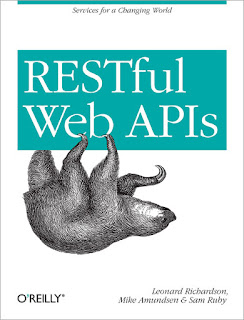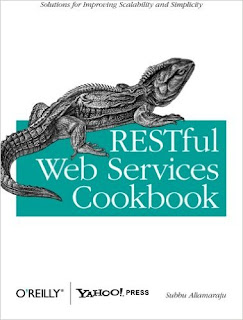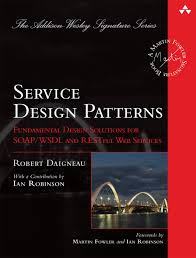In recent years, REST has become the standard style for developing web services, also known as RESTful Web Services. These web services take advantage of REST principles, which leverages all goodness of HTTP to provide scalable and robust web services. As a Java Web developer, it's high time that you get familiar with the REST concepts and the REST style of developing web services in Java, also known as RESTful web services, and nothing is better than to start with a good book. I often receive a request about which book should I read to learn REST? Or what are some best books to learn to develop RESTful Web services in Java, etc.? In this article, I will suggest some books which will teach you both designing a REST API and developing RESTful web services in Java.
The major challenge you will face not on developing RESTful web services but on designing REST API. It can be tricky even for experienced web developers as there is no standard defined for how you should create your REST API.
There is a lot of advice available online, but the more you read, the more you will confuse yourself. The classic example of this is the PUT vs. POST in REST API. Some people advocates PUT for creating resources while others will tell you to only use PUT for updating resource and POST for generating resources. You must have a solid understanding of HTTP to take the decision yourself.
When it comes to developing RESTful Web Services in Java, the Java ecosystem provides a standard set of API, known as JAX-RS, to help you develop RESTful web services.
The major challenge you will face not on developing RESTful web services but on designing REST API. It can be tricky even for experienced web developers as there is no standard defined for how you should create your REST API.
There is a lot of advice available online, but the more you read, the more you will confuse yourself. The classic example of this is the PUT vs. POST in REST API. Some people advocates PUT for creating resources while others will tell you to only use PUT for updating resource and POST for generating resources. You must have a solid understanding of HTTP to take the decision yourself.
When it comes to developing RESTful Web Services in Java, the Java ecosystem provides a standard set of API, known as JAX-RS, to help you develop RESTful web services.
There are many good implementations of this API that are available like Restlet, Jersey, Apache CXF, and RESTEasy, which you can use to kick start your work.
Btw, if you are new to the Web Service space, particularly on the Java side, then I suggest you first go through the Java Web Services course on Udemy, which will teach you how to design, create and consume both REST and SOAP Web Service in Java from scratch.
Btw, if you are new to the Web Service space, particularly on the Java side, then I suggest you first go through the Java Web Services course on Udemy, which will teach you how to design, create and consume both REST and SOAP Web Service in Java from scratch.
10 REST API, Microservices, and RESTful Web Services Books in 2025
Here is my collection of some of the best books to learn both REST API concepts and how to develop RESTful Web Services using Java Programming language and technologies like Spring framework.The list contains books that are suitable for both beginners and experienced Java web developers.
It will also help you to design your REST API better by following the tried and tested best practices and avoiding mistakes that cost you later.
1. Spring REST: Building Java Microservices and Cloud Applications
This is one of the best books if you want to learn how to develop RESTful Web Services using the Spring framework.Since Spring is the most popular and de-facto framework for developing Java web applications, it makes a lot of sense to create RESTful web services using the Spring framework like leveraging RestTemplate class.
This book will provide you all the necessary details you need to develop RESTful web services in Java using Spring. Now the second edition of this book is also available which covers Microservices and Cloud applications as well.
This book will provide you all the necessary details you need to develop RESTful web services in Java using Spring. Now the second edition of this book is also available which covers Microservices and Cloud applications as well.
If you want to learn REST API with spring quickly, you can also combine this book with the Master Java Web Services and RESTful API with Spring Boot course by Ranga Rao Karnam on Udemy. It will teach you all the modern way to create REST API using Java and Spring.
His book is platform-agnostic, so he doesn’t care whether you choose REST or SOAP or if you use PHP or Java. This book covers the entire process of designing and scaling a microservice from the ground up. It goes far beyond API design to include coding patterns, unit testing, and continuous integration.
2. Building Microservices: Designing Fine-Grained Systems 2nd Edition
The term "microservice" relates to a newer style of application development. It focuses on minimal, modularized features that each work on one task very well. Sam Newman wrote Building Microservices as an introduction to this concept.His book is platform-agnostic, so he doesn’t care whether you choose REST or SOAP or if you use PHP or Java. This book covers the entire process of designing and scaling a microservice from the ground up. It goes far beyond API design to include coding patterns, unit testing, and continuous integration.
The new second edition of the book also cover how to scale and deploy Microservices in production.
If you want, you can also combine this book with the Master Microservices with Spring Boot and Spring Cloud course on Udemy to get a practical and hands-on introduction of Microservices in Java with Spring framework. One of the best courses to learn Microservices in Java.
If you want, you can also combine this book with the Master Microservices with Spring Boot and Spring Cloud course on Udemy to get a practical and hands-on introduction of Microservices in Java with Spring framework. One of the best courses to learn Microservices in Java.
3) Restlet in Action: Developing RESTful APIs in Java
This is another excellent book to learn how to develop RESTful Web Services in Java. If you’ve ever done any Java web development, then you know that it can be complicated and sometimes downright insane. The Java Restlet framework provides the implementation of JAX-RS, which makes developing RESTful web services easier in Java.The Restlet in Action is one of the most practical books you’ll find on Java REST development. The framework is rock solid, and this book is perfect to learn Restlet and develop RESTful Web Services in Java.
4) Build APIs You Won’t Hate
This is a great book to learn and conventional technologies and best practices for building scalable RESTful web services. You’ll learn a lot of best practices with real-world PHP code examples. But you’ll also get to read about common mistakes, bugs, and anecdotes of past experiences from the authors. These anecdotes come with solutions and lessons learned in the context of API development.This book, along with the REST API Design, Development & Management course on Udemy, is the perfect resource to learn the fundamentals of REST API and avoid common mistakes that cost you thousands of dollars in your API maintenance.
Junior developers might feel this book a little bit advanced. Still, it is one of the must-reads for advanced web developers, particularly if you’re serious about REST API design and development.
The only drawback of this book is that code example are given in PHP and not in Java or C++, but the concept you will learn are too valuable to overcome this language difficulty.
5) RESTful Web APIs
This is the best book to learn the fundamental REST concepts. The author was earlier written the popular RESTful Web Services book, which this book replaces and it is one of the must-read books for beginners to learn about REST and Web Services in general. You will find a discussion about SOAP vs. REST architectures, backend languages, and JSON vs. XML response formats in this book.6) RESTful Web Services Cookbook
This is one of the few books which will teach you practical tips and tricks for your day-to-day job-related RESTful Web Services. It contains over 100 recipes related to REST API design and developing RESTful web services.Each method covers detailed scenarios and offers best practices with code snippets you can implement yourself. It’s obvious and to the point. You will learn about authentication, authorization, security, and testing of RESTful web services in this book.
The author explains the best scenarios when an API makes sense and helps you avoid common pitfalls during the development process.
The best thing about this book is that it is full of request/response design patterns, and it covers a wide variety of endpoint styles, so you will not only see the theory but also real-world examples that complement those points.
If you want to learn more about design patterns and their modern implementation in Java, I also suggest you go through the Java Design Pattern course by Dmitri Nesteruk on Udemy. He will teach you how to implement classic OOP design patterns using Java 8 features.
Even if you are an experienced programmer who is familiar with REST, you will sure to learn something by following examples in a given book, many of which you can directly apply to your projects.
The REST API Design Handbook is perfect for beginners who might not even know what REST or API stands for. You’ll learn the fundamentals of crafting a new API or connecting to an existing one.
7) Service Design Patterns
This is another excellent book for advanced developers who wants to learn to improve and scaling a modern REST API. This book covers RESTful web services in great detail, from troubleshooting to adapting the API for all users.The author explains the best scenarios when an API makes sense and helps you avoid common pitfalls during the development process.
The best thing about this book is that it is full of request/response design patterns, and it covers a wide variety of endpoint styles, so you will not only see the theory but also real-world examples that complement those points.
If you want to learn more about design patterns and their modern implementation in Java, I also suggest you go through the Java Design Pattern course by Dmitri Nesteruk on Udemy. He will teach you how to implement classic OOP design patterns using Java 8 features.
8) REST API Design Rulebook
The REST API Design Rulebook is one of the best books to learn the basic rules of CRUD and HTTP requests for API development. Since you can only design a good REST API, if you are familiar with regulations and fundamentals, it makes a lot of sense to read this book before creating a REST API.Even if you are an experienced programmer who is familiar with REST, you will sure to learn something by following examples in a given book, many of which you can directly apply to your projects.
9) The REST API Design Handbook
Cheap and super easy to follow, this 90-page handbook walks you through all the basics of designing a custom REST API from scratch.The REST API Design Handbook is perfect for beginners who might not even know what REST or API stands for. You’ll learn the fundamentals of crafting a new API or connecting to an existing one.
Design principles are a big part of this book’s content with a focus on proper implementation. API versioning and scalability are two crucial components. It may seem light, but for the price, this is definitely the best book you could nab for getting started with API work.
10) REST in Practice
To practically understand web development, you typically need to build projects and learn as you go. This is the beauty of REST in Practice because it offers so many standard solutions, design patterns, and, more important, ways of thinking that mesh with practical REST API development.You’ll learn precisely how a REST API functions and what makes it tick. You’ll learn the proper way to architect new RESTful APIs by following diagrams, charts, and code written in C# and Java.
The best part of REST in Practice is the writing style. It comes across very naturally, and it’s just easy to understand. Beginners and experts alike can find value in this book.
11) Undisturbed REST
Most online APIs work through the REST architecture. Michael Stowe’s Undisturbed REST is a great beginner’s book for introducing yourself to REST APIs. You’ll learn how they work and how to connect to other APIs with live code examples. You will also get valuable tips for designing your own API from scratch.It may not seem like a complete book on API development, but it’ll give beginners a lot to start with, and if you need some hands-on, live demonstration, RESTFul Services in Java using Jersey By Bryan Hansen course on Pluralsight is a good companion.
That's all about some of the best books to learn REST API concepts, Microservices and RESTful web services in general in 2025. The list also contains books like Spring REST and Restlet in Action, which will teach you how to develop RESTful web services using the Java programming language.
Other REST tutorials and Articles you may like
- The Complete Java Developer RoadMap (guide)
- 10 Things Java Programmer Should Learn (article)
- Top 10 RESTful Web Service Interview Questions (list)
- 10 Best Spring Courses for Beginners (best spring courses)
- 20+ Spring and REST Interview Questions (list)
- 10 Free Spring Boot Courses for Beginners (free courses)
- What is the difference between PUT and POST in REST? (answer)
- How to use RestTemplate to create REST client in Java? (tutorial)
- What are idempotent and safe methods in REST? (answer)
- How to test RESTful web services using the curl command? (answer)
- 3 REST with Spring Books and Courses for Java Programmers (courses)
- Top 10 Java Web Service Interview Questions (answer)
- How to create an HTTP Server in Java? (answer)
- 20 Spring MVC Interview Questions and Answers (questions)
- 10 Spring MVC and REST Annotations Java Developer should know (article
- 6 Courses to Learn Spring in Depth (Courses)
- 20 Spring Boot Interview Questions for Java developers (questions)
- 10 Courses to learn Microservices in Java (best courses)
Thanks for reading this article so far. If you like my recommended books, then please share it with your friends and colleagues. If you have any suggestions, books, or questions, then please drop a note, and I'll try to find an answer for you.












No comments:
Post a Comment
Feel free to comment, ask questions if you have any doubt.